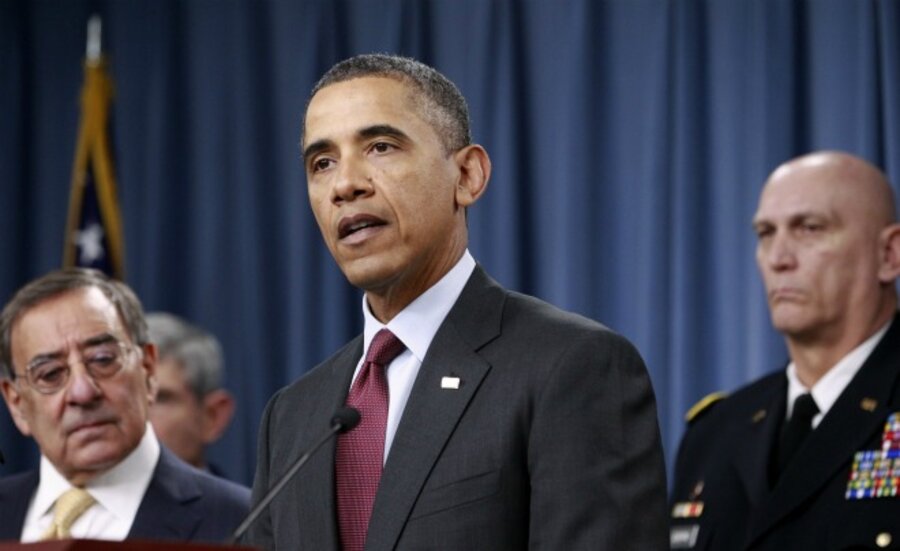Obama's 'new' defense goals aren't new – and neither are the flaws in his strategy
Loading...
| Cambridge, Mass.
Don’t get me wrong – I am pleased that the executive branch and defense establishment have developed a fresh expression of America's national defense goals and strategy from the top down, as it should be. But let’s stop calling this new guidance a “strategic pivot” or a spectacular break from the past.
The new strategic defense guidance, announced at a Pentagon press conference on Jan. 5 by the president, is primarily an apologia for having a smaller active-duty Army and Marine Corps and a clear declaration that America has suspended its interest in conflicts the size of Afghanistan or larger. The guidance foresees that the main areas of US interest will be the Middle East and the Asia Pacific region. In the Middle East the US will be “countering violent extremists and destabilizing threats” and in the Asia Pacific it will “maintain regional access and the ability to operate freely.”
Those goals are no different from what the US is attempting to do now. The main change is that to accomplish those goals, the US will not be sending large armed forces anywhere. “U.S. forces will no longer be sized to conduct large-scale, prolonged stability operations.” That’s the news.
What the guidance is really saying is that America is exhausted from the current wars and, in a twist of the old WWI song, “we won’t be back ‘til it’s over over there.”
Hotspots like Pakistan, Iran, and North Korea can rest easier for the next few years. Partners like Saudi Arabia, Israel, Japan, and South Korea should take notice that the US is drawing inward. States that are near-peer competitors like China and Russia should be reassured by America putting its rifles in the arms room. This pronouncement may do more in support of the president’s Nobel Peace Prize than anything else he has done.
Accomplishing the same strategic goals with a smaller Army and Marine Corps is not impossible. It’s just much harder, and American leaders should adjust their expectations accordingly. But since I agree with the goals themselves, I don’t have a major objection to the substance of the new guidance. In fact, I think this new guidance document is actually a slight improvement over previous defense reviews: It cost less and was done more quickly.
There are two main problems I foresee for those who will implement this new strategy, however, and they are the same problems that affect execution of all endeavors. One is the failure to stay within limited resources and the other is the tendency to plan in a vacuum. Those two errors plagued the US strategies for war in Iraq and Afghanistan, and I believe they could disrupt this new strategy.
It’s well and good to say today that America will retain a smaller Army and Marine Corps, but if tomorrow’s political leaders decide to enter a conflict bigger than projected, the country will pay in human treasure as Washington scrambles to ramp up its forces. Most observers would agree that is what happened over the past decade. Washington must be on guard against this mistake in the future and stay within its new limits.
Second, US leaders must avoid planning in a vacuum. In preparing for post-war Iraq and Afghanistan, uniformed and civilian defense planners liberally assigned tasks and responsibilities to diplomats and developers who were never fully part of the planning process. The new guidance seems to repeat this error when it says, “Meeting these challenges cannot be the work of the military alone which is why we have strengthened all the tools of American power, including diplomacy and development, intelligence, and homeland security.”
I wonder if those who wield these other tools of American power feel that they have been sufficiently “strengthened” by increased funding and personnel to assume the duties the defense establishment has assigned them. And I wonder if they feel adequately vested in the new defense strategy, since nowhere in the guidance is there any mention by the president or secretary of coordination with those agencies. I have my doubts.
Retired Brigadier General Kevin Ryan is executive director for research at Harvard Kennedy School’s Belfer Center for Science and International Affairs. His last duty assignment in the Army was Deputy Director, Army Strategy, Plans, and Policy.
A version of the piece also appeared on the Power & Policy blog at Harvard Kennedy School’s Belfer Center for Science and International Affairs.







